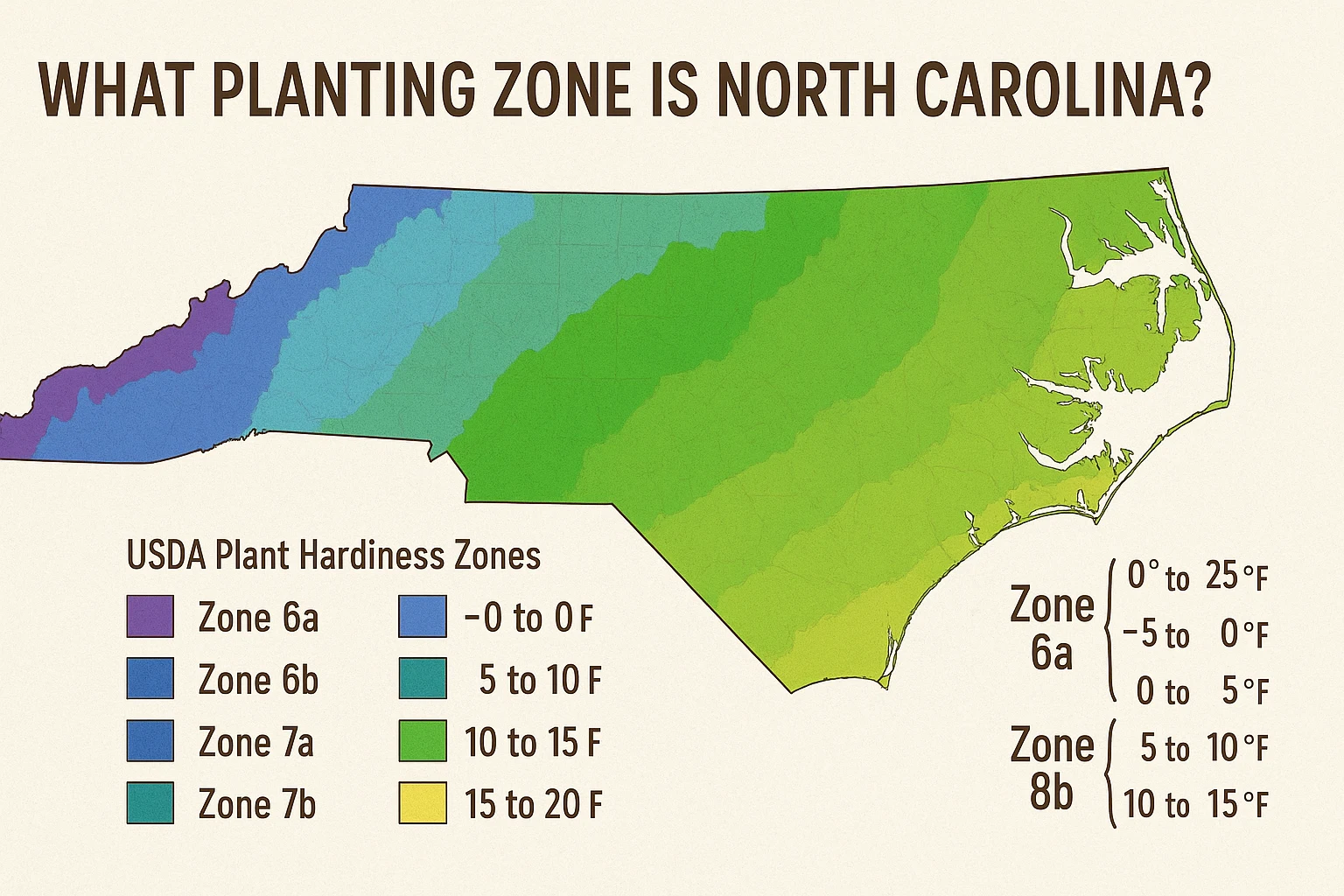What Planting Zone is North Carolina?[Map, Cities, and Growing Tips]

What planting zone is North Carolina? If you’re planning a garden or landscaping project, knowing your USDA planting zone is the key to success. North Carolina’s diverse climate spans mountain ranges, piedmont plateaus, and coastal plains, making planting zones especially important for choosing the right plants.
This guide will explain what planting zone is North Carolina, how it varies by region, and what it means for your garden.
🌿 What Planting Zone is North Carolina?
North Carolina’s planting zones range from 6a to 8b, with most of the state falling within zones 7a, 7b, and 8a. The mountains in the west are cooler, while the central and coastal regions are warmer.
| Region | USDA Planting Zone |
|---|---|
| Western Mountains (e.g., Boone, Asheville) | Zones 6a – 7a |
| Central Piedmont (e.g., Charlotte, Raleigh) | Zones 7b – 8a |
| Eastern Coastal Plain (e.g., Wilmington) | Zone 8a – 8b |
If you’re wondering what planting zone is North Carolina in your area, it depends on both your location and elevation. Lower elevations and coastal areas are warmer, shifting you into higher zones.
🌱 North Carolina Planting Zones by City
| City | Planting Zone |
|---|---|
| Asheville | Zone 7a |
| Charlotte | Zone 8a |
| Raleigh | Zone 7b |
| Greensboro | Zone 7b |
| Wilmington | Zone 8b |
| Boone | Zone 6a |
| Durham | Zone 7b |
| Fayetteville | Zone 8a |
The easiest way to check what planting zone is North Carolina for your exact location is to look up your zip code on the USDA Plant Hardiness Zone Map.
🌡️ Why North Carolina’s Planting Zone Matters?
Understanding what planting zone is North Carolina helps you:
- Choose perennials that survive winter
- Time your vegetable plantings correctly
- Avoid planting species that won’t tolerate local temperatures
For example, a plant hardy to Zone 6 might thrive in Boone but fail in Wilmington’s Zone 8b heat and humidity. Conversely, tropical plants that flourish in Wilmington would not survive Asheville’s colder winters.
🧠 Example: Tomatoes in Zone 6a vs. Zone 8b
In Boone’s Zone 6a, tomatoes are typically planted in late May after the last frost. In contrast, Wilmington’s Zone 8b allows for tomato planting as early as mid-March, giving gardeners a longer growing season and even the chance for multiple harvests.
This variation shows why knowing what planting zone is North Carolina in your area is essential for successful gardening.
📅 When to Plant in North Carolina (By Zone)?
| Crop Type | Zone 6a Start | Zone 7b Start | Zone 8b Start |
|---|---|---|---|
| Cool-weather (lettuce, kale) | Mar–Apr | Feb–Mar | Jan–Feb |
| Warm-weather (tomatoes, peppers) | Late May | Apr–May | Mar–Apr |
| Perennials | Fall or early spring | Fall or early spring | Fall (best) |
Your local North Carolina planting zone affects your frost dates, growing season length, and planting schedule.
💡 Gardening Tips for North Carolina’s Climate
- Mountains (Zone 6a-7a): Focus on cold-hardy perennials and short-season vegetables.
- Piedmont (Zone 7b-8a): Great for a wide range of veggies, flowers, and fruit trees.
- Coastal Plain (Zone 8b): Ideal for heat-tolerant and humidity-loving plants.
General Tips:
- Mulch to manage moisture and soil temperature.
- Watch for pests common to North Carolina’s humid summers.
- Amend clay-heavy soils in the Piedmont region for better drainage.
🧮 Recommended Tools for North Carolina Gardeners
Planning to plant smarter? Use these free calculators:
- Soil Volume Calculator – Know exactly how much soil you need for raised beds.
- Plant Spacing Calculator – Prevent overcrowding and maximize yield.
- Indoor Plant Watering Calculator – Perfect for your houseplants or container garden.
🙋 Frequently Asked Questions
What planting zone is North Carolina in general?
Most of North Carolina falls between Zones 7a and 8a, with mountainous areas in Zone 6a and coastal areas reaching Zone 8b.
Can you grow citrus in North Carolina?
In Zone 8b (coastal areas), hardy citrus varieties like satsumas can be grown outdoors. In Zones 7 and 6, citrus must be container-grown and brought indoors in winter.
When is the last frost in North Carolina?
- Zone 6a: Late April to early May
- Zone 7b: Early to mid-April
- Zone 8b: Early March
✅ Conclusion: Why Knowing North Carolina’s Planting Zone Matters
Understanding what planting zone is North Carolina ensures you plant species that can survive and thrive in your local conditions. From Boone’s frosty hills to Wilmington’s coastal breezes, North Carolina’s diverse zones shape every gardener’s experience.
Before you plant, always check your exact zone, plan accordingly, and give your plants the best chance to flourish.
🌿 Happy gardening, North Carolina!
